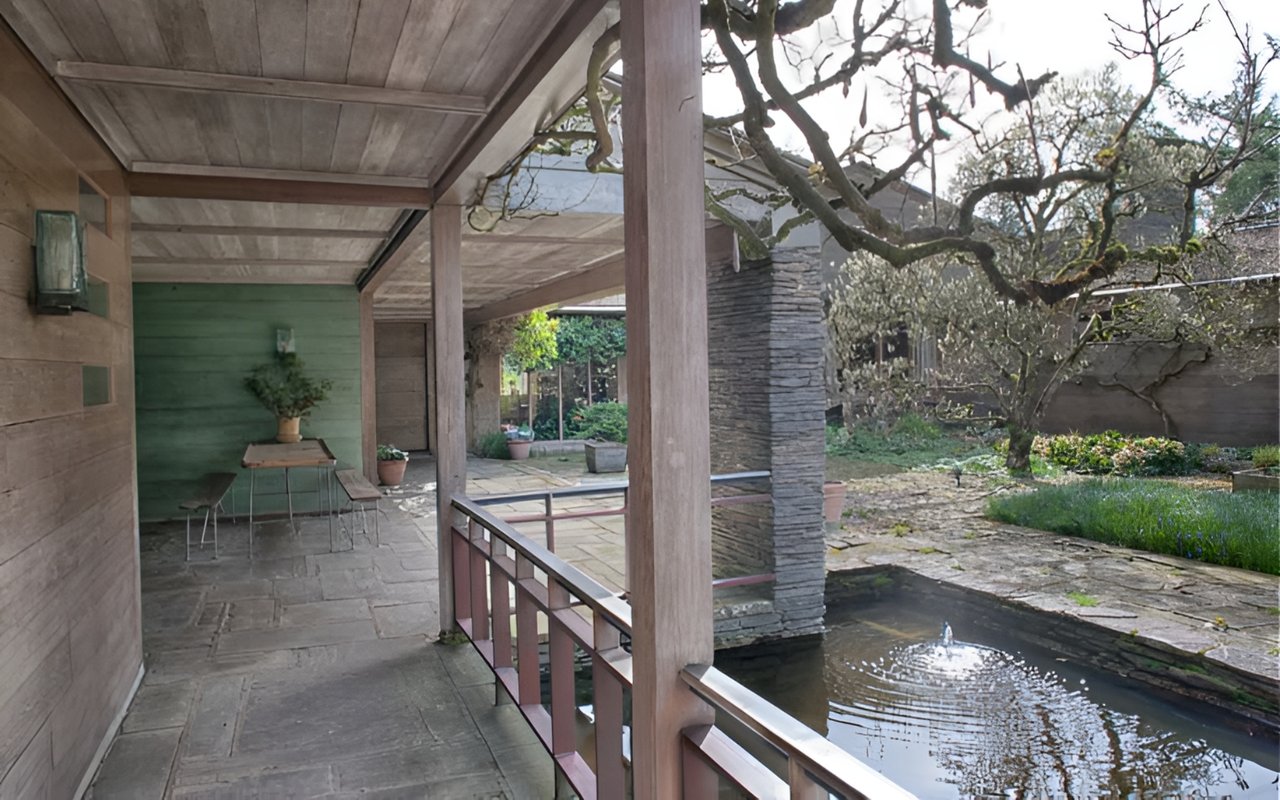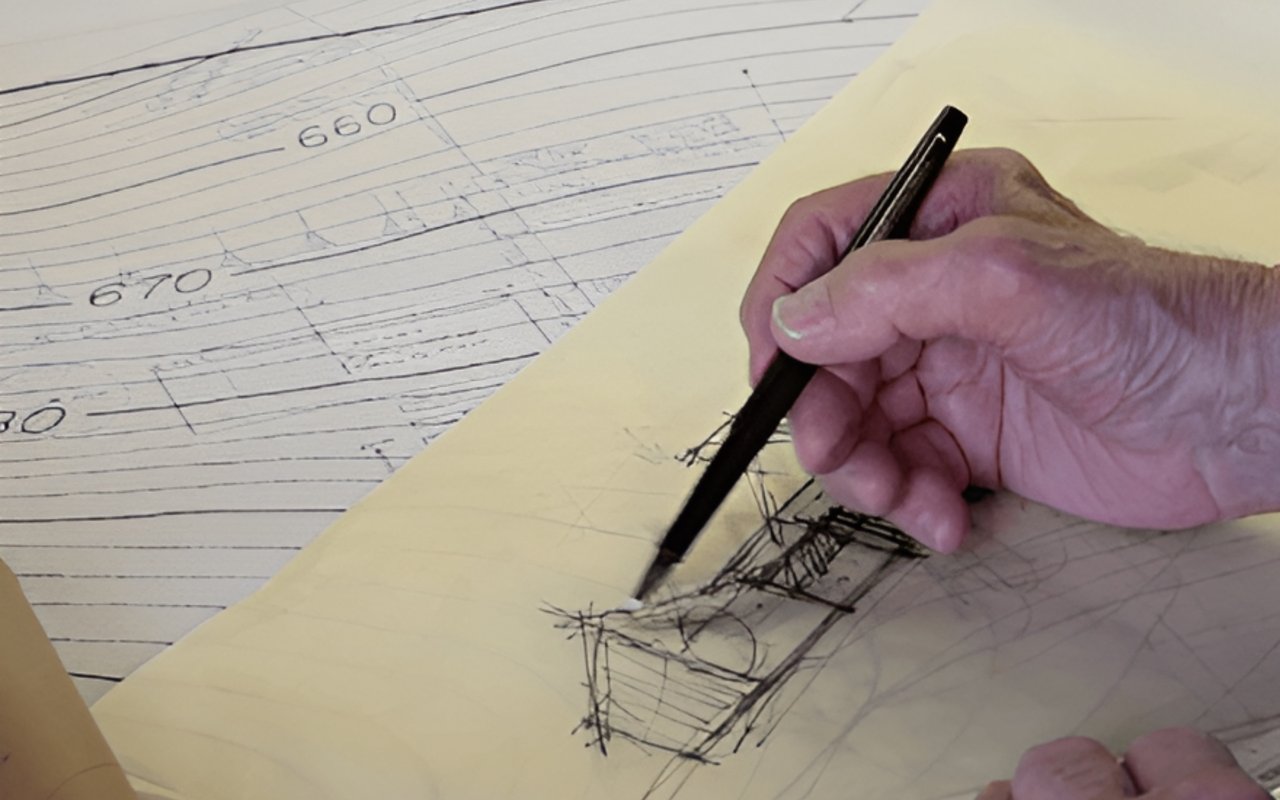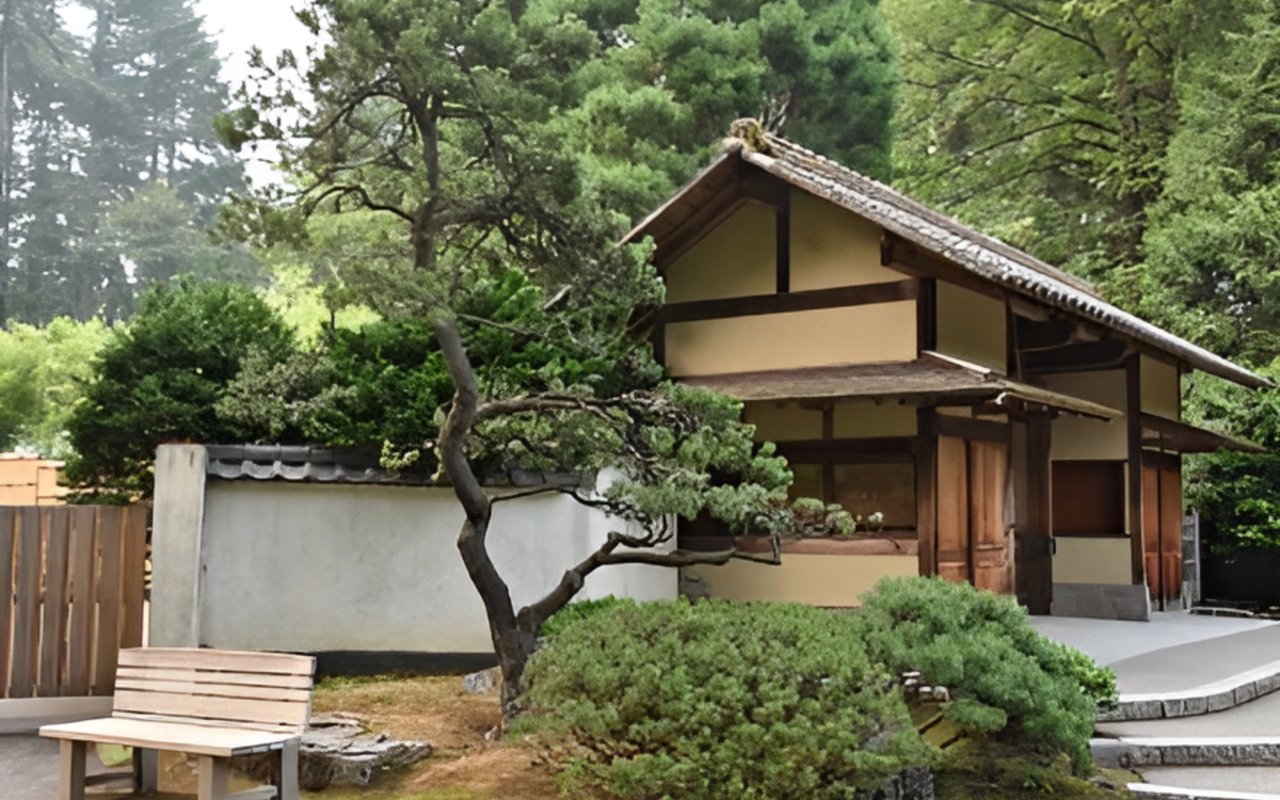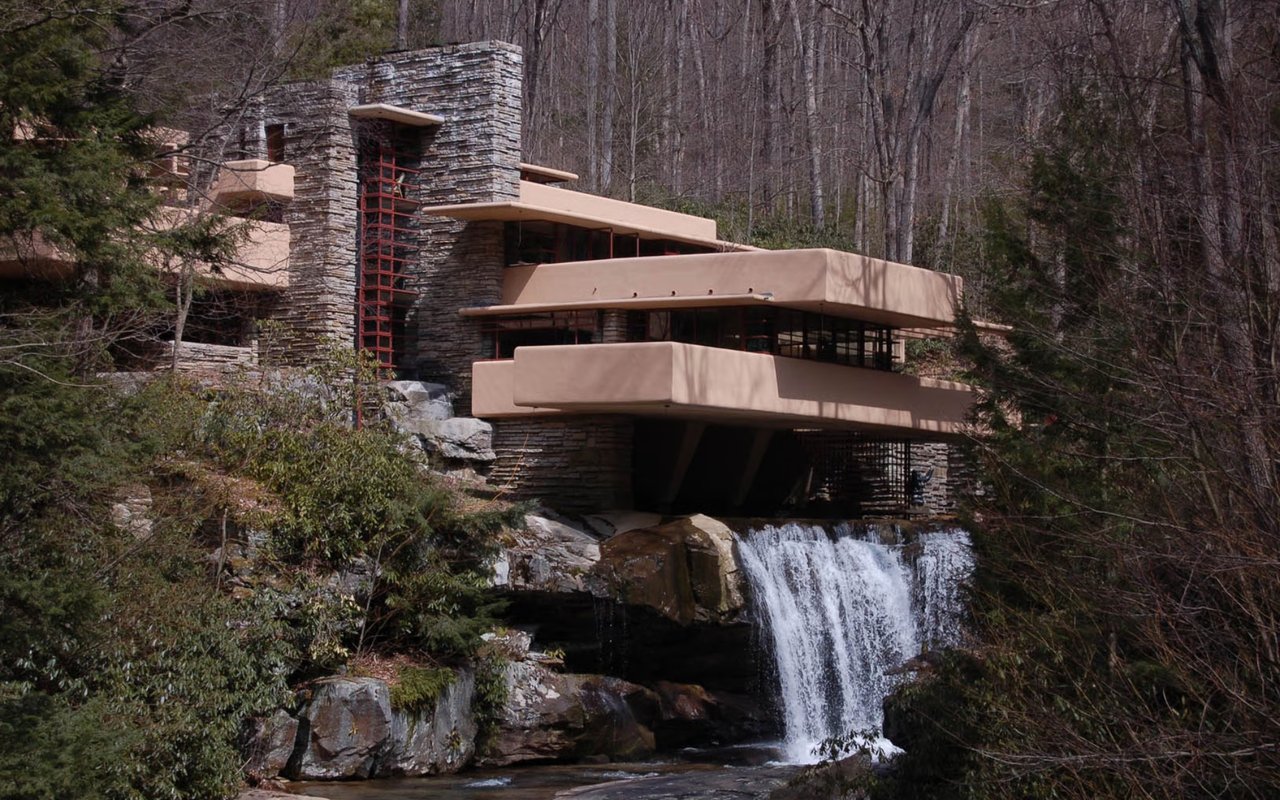In preparing this “sketch” I relied heavily on an interview that Marian Kolisch conducted with John Yeon and which is part of the Oral History Interviews in the Archives of American Art, Smithsonian Institution. Other sources are referenced in parenthetical notes referring to “sources” list at the end of the piece. BZ
John Yeon was born in Portland in 1910 and was raised in the Mocks Crest area of north Portland. He became one of the region's most celebrated architects and intellects, achieving national and international recognition. His architectural work has an elegance and refinement that reflects an intense attention to detail and an emphasis on composition and proportion not only in form but in how one moves through space.
The list of Yeon’s built work is not long. In 1937 he had his first built commission, the Watzek house. It is perhaps his best known work and was remarkable for the time and is remarkable still. It was included in both the 10th and the 15th anniversary exhibits at New York Museum of Modern Art (Gragg, web). The builder of the Watzek house, Burt Smith, was so impressed with Yeon’s work that he had him design some small houses that he could build on speculation. They became known as the “plywood houses.” Two were built in the southwest hills off of Barnes Rd and two were built in north Portland (interestingly in the Mocks Crest area). Around six more plywood houses of subtly different designs were built in Lake Oswego. Yeon also referred to the Jorgensen house as one of the plywood houses but it is on a larger scale and it was done on commission. There was another handful of private homes he did as commissions in addtition to the Watzek House (Jorgenson 1939, Vietor 1941, Van Buren, Shaw 1950, Swan 1950, Cottrell 1950, Corbett? ). He began the design of the Portland Visitors Center in 1947 (Ritz, Richard, Architects of Oregon, p.444) which is often referred to as his only commercial building, but he also did a small office building for a real estate firm. He did museum gallery installations in Kansas City, Portland and San Francisco.
Yeon never completed formal architectural studies. In his own words “I didn’t graduate from anything. I didn’t graduate from grammar school, from high school, or college. I did graduate from sunday school”(Kolisch Interview ). A lack of degrees does not equal a lack of instruction; he seems to have attended a number of fine schools on all levels around the country but simply accelerated out of them, moving on to the next level before completing the one he was in.
Responding to a question by Kolisch as to when he became interested in architecture, Yeon responded, “I don’t know when it started. But when Mocks Crest was developed, of course, there were houses built and I watched very, very carefully. I seemed to know that’s what I was interested in because I stopped going to the beach in summer at my own request and stayed in Portland and worked as an office boy in the Doyle office. And later [as] an office boy in [Brookman’s] office. I didn’t learn much architecture then because I always ended up either making models or doing renderings or fancy pictures.”
“I went to college in 1929. I was only at Stanford one quarter and my father died. …I came back at the time of his death and never went back to Stanford. Instead I went to New York and worked at an architect’s office [Young, Moskowitz and Rosenbloom] by prearrangement from Portland, and went to Columbia at night. …I lived in a little room up by Columbia. However, Columbia was excruciatingly boring. I had to take courses on, you know, how to put water tanks on top of buildings in New York and so on. And I’m afraid I misbehaved very badly. I kept the job but I kept dropping out of classes and New York became very glamorous at night. Instead of night school, I met fascinating people and that interrupted my formal education. [But] I was impatient, terribly impatient. I had all kinds of things I wanted to accomplish that more formal education wouldn’t allow.”
His interest in architecture was matched and perhaps eclipsed by his interest in landscape and nature conservancy. Gardening was an early interest–he fondly remembered gardening with his grandmother at the Mocks Crest home and designing a garden for himself as a boy. Richard Ritz called a rose garden he designed in 1933 for his mother’s house “perhaps the most original twentieth century landscape garden design in the Northwest” (p444). His father, who came to Oregon from Canada as a logger and had success introducing some mechanical innovations and who ultimately became an investor in Portland real estate, supervised the building of the first scenic highway in the Columbia gorge (approx 1915-1917). Young Yeon travelled extensively with his family throughout Oregon prior to the establishment of a truly accessible public road system and this exposure to undeveloped Oregon made a lasting impression on him.
He was appointed, at age of 21 by Oregon governor Meir to the Oregon State Parks Commission. This appears to have been the beginning of a life long involvement in regional planning issues relating to the Northwest landscape and its preservation.
Early on he demonstrated an ambition and conviction that is telling of his passion concerning the landscape. The then Oregon Highway Department had a proposed new highway at Neahkanie Mountain at the Oregon coast which “had a great straight line across the base of the mountain which involved blasting great portions of it into the sea.”(Kolisch interview) The Department had also proposed a new highway through the Columbia Gorge “and below Crown Point, Baldock (the chief highway engineer) had designed this great gash across there three miles long through the bottomlands”(ditto). Failing to make headway in convincing Oregon officials to reconsider these alignments, Yeon travelled to Washington D.C. (apparently on his own resources) and succeeded in meeting with the chief of the Bureau of Public Roads. The meeting resulted in the national official sending his top landscape architect to Oregon for consultations with the local engineers. Ultimately the design of both projects was adjusted to alignments sympathetic to the natural topography.
His involvement with Chapman Point in Cannon Beach, acreage adjacent to what had become Ecola State Park further illustrates his commitment to protecting Oregon’s landscape. It is a tract of land that is in the foreground of the famous view from Ecola Point to the south towards Haystack Rock. “Everyone thinks that it is part of the park, but it isn’t.” It had been sub-divided into lots and streets in 1890. It came up for sale when Yeon was on the State Parks Commission and the commission recommended purchasing the property and adding it to Ecola State Park. Such decisions were made by the chairman of the Oregon Highway Commission, who refused to purchase it. Rather than let it fall into the hands of developers Yeon borrowed money and purchased the property with the hope of selling it to the state when commissioners changed.(Ditto). The continuation of the story of Chapman Point is a story worth telling, but this is not the place for it.
“I can’t explain why I was such a sucker for for landscape, but it’s been a great interest in my life, in particular the Oregon landscape. I suppose just because I was born here. It’s what I knew early on. I early on was interested in architecture which would fit that unique landscape that I liked so much”(ditto).
It is this combination of Yeon’s interest the landscape and his interest in the built environment that resulted in what is so singular about his architectural work and perhaps is why such a relatively short list of built projects has had such a lasting and broad impact: his is a disciplined architecture of place. And it is not just a wink and a nod as in ‘each project has to be a response to the site.’ Each project is the site. His work is the essence of regional architecture.
In Yeon’s own words: “Well there’s lots of people interested in regional architecture now. I think part of it is just chauvinism. They want this region to have some distinctive architecture that they can boast about. …to me, regional architcture only means an architecture related to a specific regional landscape….it’s a building in the landscape” (ditto).
Meredith Clausen, in her book on Pietro Belluschi put it this way:”Yeon sought a regional architecture, but from a perspective differing radically from Bellushici’s. Yeon saw Northwest architecture not as a matter of local building materials or climatic conditions, factors he thought obvious, but as a deliberate aesthetic choice of forms sympathetic to the landscape, architectural forms that visually merged with the lines and planes of the natural terrain. His design approach was that of a landscape painter–like Cezanne with his sliding, dissolving planes, or the Chinese landscapists–but now working in three-dimensional space, imagining how the building would fit visually, compositionally into the whole.” (p.95)
The forms and materials Yeon chose to achieve the melding of building and landscape are often traced back to the influence of a small coastal cottage at Neahkanie on the Oregon coast. The cottage was built by Harry Wentz, a prominent Portland artist and much loved teacher at the Musem Art School. A.E. Doyle is the architect of record for the house but Yeon noted that it was not like anything Doyle had done before. He thought that Wentz must of had much to do with the design. The cottage made a lasting impression on Yeon:
My first visit to Neahkanie, I remember very clearly. I had met Harry Wentz in A.E. Doyle’s office. He was a good friend of Mr. Doyle– where I was an office boy– and we met. And eventually, I wanted to call on him at his house in Neahkanie and I went there on a typical sort of beach day. There was fog shrouding the mountain. But I remember going into the house and it was the first really beautiful piece of architecture, at least in Oregon, that I had experienced.
The house was all wood, of course, and the inside was exposed structure. It wasn’t built the way an ordinary house is in Oregon, on two-by-fours with an air space. The structure was built more like a barn, actually, with the timbers exposed and just [sheeting] on the outside. All this was in spruce, which had never been finished and had a very pearly lustre like the inside of a sea shell. Looking out of the big north window you looked right down the side of the mountain– the mountain coming out of the sea. And the window was surrounded with spruce tree branches, all making a very nice composition. The day I was there, the fog was settled on the mountain but it was silhouetting the pinnacle along the road, which made it stand out, and it made the whole thing seem very vast and mysterious.
Yeon is often referred to as a northwest regional architect–indeed often as one of the founders of that style. Whether a northwest style even exists is an entertaining question to ponder. Perhaps Richard Ritz observation that both Yeon and Belluschi preferred the idea of “Regional Interpretation of the International Style” (p444) is an accurate place to let it rest. Yeon said “I insist on thinking that [regional architecture] is a deliberate effort to interpret the specific landscape. In that, I may be way out on a limb by myself, but that’s what is thrilling to me” (Kolisch).
What ‘style’ a designer uses in achieving the fit of structure into a site wasn’t that important. In his own work Yeon seemed to accept the reference “barn style” (a term others used in describing his work) and palace style “of which the only–the most visible result” was the Shaw house(ditto). The Portland Visitors Center is often referred to as an example of Yeon working pretty literally in the International Style. Yeon referred to the Corbett house as his only built work with post modernist leanings but he observed that several other unbuilt works were unconsciously moving in a post modernist direction. Pondering the interior of the Watzek House, one feels a definite appreciation and reference to classical European traditions from the seventeenth and eighteenth centuries.
Ultimately what impresses about Yeon’s work is a sense of correctness. He endeavored “to make things calm, serene.” Being in one of his buildings you appreciate that he accomplished that through discipline, proportion and attention to detail. Douglas Lynch, a Portland graphic artist who was part of the design community contemporary with Yeon and also Beslluschi and Van Evera Bailey said, “When Van Bailey built you a house he joined your family and moved in. When Belluschi built a house you became aware of 2000 years of civilized transactions. When John Yeon built you a house you moved in and acceded to his ascetic precision and refinement; you became a custodian of a Yeon house”(notes).
Sources
Sources
John Yeon Interviews (conducted by Mariam Kolisch), 1982 Dec. 14-1983 Jan.10, Archives of American Art, Smithsonian Institution. Web transcript.
Clausen, Meredith. Pietro Belluschi Modern American Architect. Cambridge, Ma: The MIT Press, 1994. Book.
Gragg, Randy. “Architect &Preservationist John Yeon Creating a Lasting Impression”, Oregon Cultual Heritage Commission, 2000. Web
Ritz, Richard. Architects of Oregon. Portland, Or: Lair Hill Publishing, 2003. Book
Ritz, Richard. Architects of Oregon. Portland, Or: Lair Hill Publishing, 2003. Book
Lynch, Douglas. Notes and personal recollections prepared at the request of Walter Gordon for a lecture on Van Evera Bailey.



